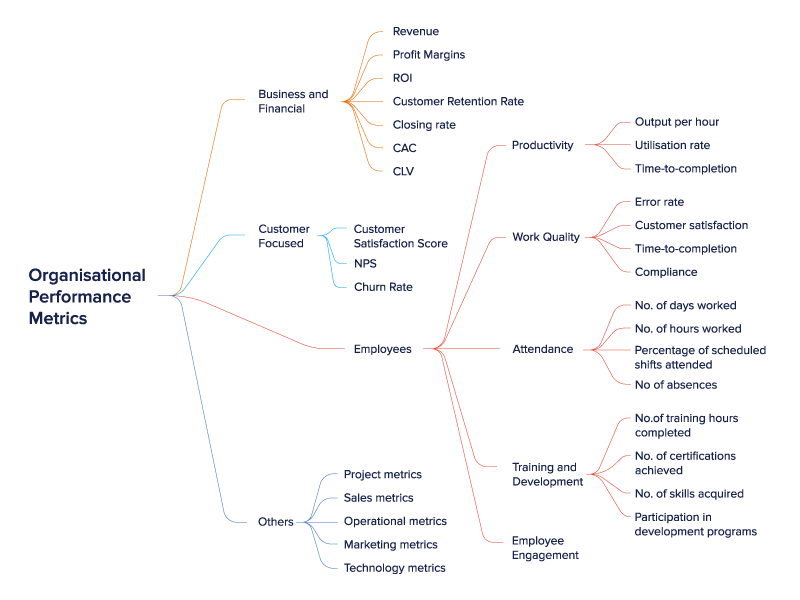Understanding Performance Metrics Definition, Advantages, and Metrics to Track

Table of Contents
Peter Drucker, the father of management thinking, has asserted many times that you can’t improve what you don’t measure. Organisations that aim to improve should monitor and measure their operations. However, organisations should also note that many factors like loyalty, integrity, and confidence, are not easily quantifiable. What organisations can measure are their financial performance, customer satisfaction, employee engagement, and marketing effectiveness. Measuring these gives them an understanding of their operations and helps them make data-driven decisions for improvement.

What are Performance Metrics?
The American Society of Quality defines performance metrics as – “Performance metrics are defined as figures and data representative of an organisation’s actions, abilities, and overall quality.” Performance metrics can be used to gauge the performance of the organisation as a whole, or individual employees or teams. With this information in hand, they can identify improvement areas. Most metrics are not stand-alone and do not, by themselves, qualify or disqualify the parameters they measure. After measurement, metrics should be assessed in the context of other metrics, rather than individually.
How do Businesses Benefit by Tracking Performance Metrics
Performance metrics help organisations track progress, set goals, and make informed decisions about improving performance.
Here are some ways in which companies can use performance metrics:
Better Decision-making
Companies can use the data derived from measuring performance metrics to make better decisions for the business. This can be done by identifying their areas of strengths and weaknesses. Then companies can set goals and allocate resources more effectively.
More Efficiency and Productivity
Measuring performance metrics can help organisations in finding the bottlenecks in their processes. This can be used to make improvements to increase efficiency and productivity.
Increased Customer Satisfaction
Some performance metrics like customer satisfaction index and customer retention rate can be used to understand the efficacy of your customer satisfaction programs. Companies can find opportunities to improve the customer experience and increase loyalty, by tracking these metrics regularly.
Enhanced Financial Performance
Companies can track financial metrics like revenue, profit margins, and return on investment. This can help them to monitor their financial performance. By regularly tracking these metrics, companies can figure out opportunities to improve profitability.
What is the Difference Between KPIs, Metrics, and OKRs
Performance indicators are any metrics when viewed within the context provide a sense of progress towards a specific goal. KPIs (Key Performance Indicators) are some of those metrics which are ranked above other indicators and are agreed as the metrics which would be used to gauge the success of an organisation or individual. These metrics are selected based on the specific goals and objectives that an organisation or an individual is committed to achieving. These metrics provide a snapshot of performance or progress towards the goals.
Metrics, in general, mean the measurement of meaningful data pertaining to a process, a system or an outcome. Metrics will need context and interpretation to arrive at the performance of an organisation, team, individual, process, system or strategy. The interpretation of metrics helps in identifying what is working well and what needs to be improved.
OKRs (Objectives and Key Results) is a goal-setting framework used to set clear and measurable goals and track progress towards achieving them. OKRs are often used with metrics to track progress and identify areas for improvement.

What are the Different Types of Performance Metrics?
For an organisation to function properly, it needs to evaluate several areas consistently. These can be done by setting up performance metrics and tracking them.
The core focus areas of an organisation are its business/finance, employees, and customers. Hence the performance metrics should be related to
- Business and Financial Performance
- Employee Performance
- Customer Focussed Performance
The three areas mentioned above are inherently interrelated. Various departments and employees at various levels are responsible for the metrics in each of these areas. Ultimately, the activities performed at an individual level result in the collective success of an organisation.

Business Performance Metrics
Companies use business performance metrics to understand and assess their business’s performance. The business performance metrics are used to find the impact of the various processes the company has set, and the effect of different systems used. Like any other metrics, these will help understand the areas requiring improvement.
Since every business is unique in its makeup, it will have its own set of KPIs defined and to be tracked to measure progress. There are, however, some metrics which are generally accepted as KPIs for any business that intends to make profits. Some of such KPIs are:
Revenue
It is a good indicator because it shows how much money the business generated by selling its goods or services. Higher the revenue, the better the performance.
Profit Margin
Profit is broadly calculated as the total revenue minus the costs incurred by the company. Profit margin is the percentage of profit made against the costs. Businesses usually aim to get a higher profit margin.
Return on Investment (ROI)
For any company to operate and do business, it needs to invest money. These investments are usually on office premises, tools and staff. ROI is revenue earned for the investment it made.
Customer Retention Rate
Retaining customers is more cost-effective than obtaining an equal number of new customers. That is why companies are keen on this metric that measured as the percentage of customers who continue to be associated with a business and its products during a specific period of time.
Lead Generation Rate
It’s a simple yet important metric. It represents the number of leads a business has been able to generate in a given period.
Closing Rate
This is the percentage of closed or successfully completed sales.
Customer Acquisition Cost
CAC is calculated by summing up all the costs, including marketing and sales expenses, incurred to acquire a new customer.
Customer Lifetime Value
It is calculated by finding the total amount of money a customer can spend over the lifetime on the company’s products or services. Customers with high CLV are of special interest to organisations and develop strategies to retain them.
Learn more about other business metrics to track in this Forbes article.
Employee Performance Metrics
These metrics are measures that are used to evaluate the performance of individual employees or teams. These are used to assess the effectiveness and identify employee performance improvement areas. Some common examples of employee performance metrics include:
Productivity
This is a measurement that can gauge the efficiency and effectiveness of a team or an individual and reflects on their performance. It measures the amount of work that is completed per a specific time period. Ways to measure productivity include:
- Output per hour: It is the number of units or tasks an employee or team can complete in an hour. A higher output per hour indicates higher productivity.
- Utilisation rate: This measures the percentage of time that an employee or team is actively working on tasks. A higher utilisation rate indicates higher productivity.
- Time-to-completion: It simply is the amount of time required to complete a given task or project by the team or an individual. The lesser time it takes to complete the task indicates that productivity is higher.
Work Quality
Though the word quality sounds like a subjective description by the consumer of the goods or services, it can be measured using indirect metrics. This is a measure of the product or service against the specific requirements or standards which are usually pre-determined. This in turn indicates the performance of the team/individual in producing the output to the exacting standards. Some ways to measure work quality may include:
- Error rate: It is the number of mistakes or defects in an employee’s work. An employee is regarded as producing high-quality work when the error rate is low.
- Customer satisfaction: Quality is usually how the customer perceives the product or service received. Companies seek customer feedback to understand how satisfied they are with the employee’s output. More highly satisfied customers indicate high-quality work by the employee/team.
- Compliance with standards: Monitor how well employees follow established standards or procedures. High levels of compliance can indicate high-quality work.
Attendance
Regular attendance is often essential for the smooth functioning of an organisation. Hence, attendance is an important metric for evaluating the performance of employees. Ways to measure attendance include:
- Number of days worked
- Number of hours worked
- Percentage of scheduled shifts attended
- Number of absences
Training and Development
This is an indirect metric to gauge the performance of the employee. More training received could indicate improved knowledge and skills for the employee. A well-trained employee whose knowledge is on par with the industry is expected to perform better. Some common ways to measure training and development include:
- Number of training hours completed
- Number of certifications achieved
- Number of skills acquired
- Participation in development programs
Employee Engagement
This measures how involved and committed employees are to their work and the organisation. Employee engagement can be measured through surveys or other methods.
A robust tool which helps in managing all aspects of employee performance is a great asset to any organisation.
Customer-Focussed Performance Metrics
It is important to know how the company is engaging its customers with its products and services. Satisfied customers tend to recommend to others and the company only gains from this. These metrics give insight into the satisfaction levels and engagement of customers.
Customer Retention Rate
Retaining customers is more cost-effective than obtaining an equal number of new customers. That is why companies are keen on this metric that measured as the percentage of customers who continue to be associated with a business and its products during a specific period of time. These are, in a way, repeat customers.
Customer Lifetime Value (CLV)
It is calculated by finding the total amount of money a customer can spend over the lifetime on the company’s products or services. Customers with high CLV are of special interest to organisations and develop strategies to retain them.
Customer Satisfaction Score (CSS)
This is a metric for customers’ satisfaction levels with a company’s products or services. It can be measured through surveys or polls. Businesses need their customers to be highly satisfied as they not only return to for more services or products but also recommend them to others.
Net Promoter Score (NPS)
This metric too is an indirect measure of customer satisfaction and is measured using surveys. NPS is an indication of customer loyalty and is measured by the survey question about how strongly they would recommend the company’s services or products to their friends and relatives. The score usually ranges from -100 (minus 100) to 100 (plus 100).
Churn Rate
This is a metric that is the opposite of customer retention. It identifies the number of customers who have stopped engaging with the company during a period of time. The lesser the churn rate, the company is successful in retaining its customers.

Other Important Metrics
Apart from these core metrics, organisations can measure various other metrics:
Project Metrics
These quantitative measures are used to assess a project’s progress and success. Cost, schedule, quality, and scope are examples of these metrics. Cost overruns, schedule deviation, number of faults, and percentage of requirements met are examples of specific metrics.
Sales Metrics
If companies need to understand how their sales teams are performing and the effectiveness of their sales efforts, these metrics give clear insights. Identifying areas for improvement and making data-driven decisions on its products and services becomes a breeze. Some of the sales performance metrics that companies track include measuring sales revenue, volume, conversion rate, cycle, quota attainment, average sale price, etc.
Operational Metrics
Operational metrics are used to assess an organisation’s operational efficiency and production. Cycle time, mistake rate, and on-time delivery rate are examples of operational measures.
Marketing Metrics
Understand the effectiveness of marketing campaigns and strategies using marketing metrics which include website traffic, conversion rate, and lead generation rate.
Technology Metrics
These metrics include uptime, system performance, and security breach rate.
Understanding performance indicators is critical for every company striving to enhance its operations and reach its objectives. Performance metrics are measurements that provide information about efficiency. Depending on their requirements, businesses can track a variety of KPIs. Businesses can better understand their performance and take appropriate steps to enhance it by monitoring and assessing these data on a regular basis.
Grow your business with factoHR today
Focus on the significant decision-making tasks, transfer all your common repetitive HR tasks to factoHR and see the things falling into their place.

© 2025 Copyright factoHR


